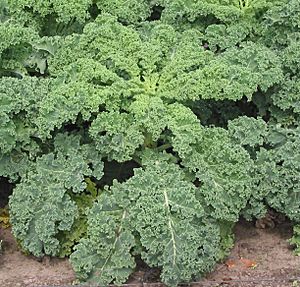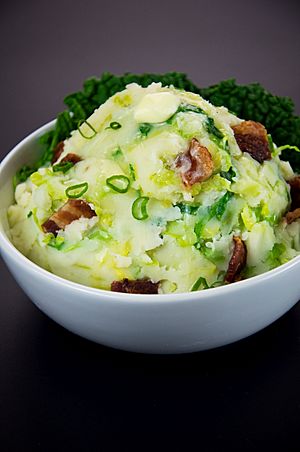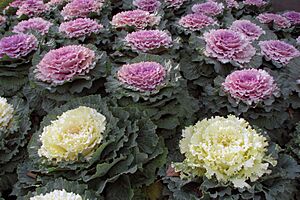Kale facts for kids
Quick facts for kids Kale |
|
|---|---|

Curly kale
|
|
| Species | Brassica oleracea |
| Cultivar group | Acephala Group |
| Origin | Unknown, before the Middle Ages |
| Cultivar group members | Many, and some are known by other names. |
Kale is a leafy green or purple vegetable. It is also known as borecole. Kale belongs to the Brassica oleracea family, which includes other vegetables like cabbage. Its flowers have a special shape, which is why it's called a cruciferous vegetable.
Kale leaves are usually large and curly, with a strong flavor. They can be light green, dark green, or even blue-green. Unlike some cabbages, kale leaves don't form a tight head. This is why its Latin name, "acephala," means "without head." The leaves grow on a thin, whitish stem that can be 30 to 40 cm (12 to 16 inches) tall. Some types of kale are so pretty that people grow them just for decoration!
Contents
Where Does the Name "Kale" Come From?
The word "kale" comes from an old English word, cale. You can still hear similar words today, like kail in Scotland and Kohl in Germany. All these words mean different kinds of cabbage. The very first origin of the word is from the Latin word caulis, which also meant 'cabbage'.
Growing Kale
Kale is a very tough plant from the cabbage family. It can grow even when it's super cold, down to about -15 °C (5 °F)! But it doesn't like hot weather. Because it handles cold so well and grows easily, kale was a popular winter vegetable. It was especially loved in places like Scotland, Germany, Holland, and Scandinavia. Today, people all over the world enjoy eating kale.
History
Kale first grew in the eastern Mediterranean region and a place called Anatolia. People started growing it for food around 2000 BCE, which is about 4,000 years ago! In Greece, curly and flat-leaved cabbages were already common in the 4th century BC. The Romans called these early types "Sabellian kale." We believe these are the ancestors of the kale we eat today.
In western Europe, the first records of cabbages appeared in the 1200s. By the 1300s in England, people were already telling the difference between cabbages that formed a tight head and those with loose leaves, like kale.
In the 1800s, traders from Russia brought Russian kale to Canada and then to the United States. A scientist named David Fairchild from the USDA helped introduce kale to Americans. He brought it back from Croatia. Fun fact: Mr. Fairchild actually didn't like cabbages, including kale! In Croatia, kale was popular because it was easy to grow and cheap. It also helped improve the soil.
Why Kale is Good for You: Nutrients
Kale is packed with important vitamins and minerals. It's an excellent source of Vitamin K, Vitamin A, Vitamin C, and Manganese. These help your body stay healthy and strong.
It's also a very good source of fiber, Copper, Tryptophan, Calcium, Vitamin B6, and Potassium. Fiber helps your digestion, and calcium is good for your bones.
Kale gives you a good amount of Iron, Magnesium, Vitamin E, Omega 3 fats, Vitamin B2, Protein, Vitamin B1, Folate, Phosphorus, and Vitamin B3. Eating kale is a great way to get many nutrients your body needs!
| Nutrient | % Daily Value | World Healthiest Foods Rating |
|---|---|---|
| Vitamin K | 1327.6% | excellent |
| Vitamin A | 354.1% | excellent |
| Vitamin C | 88.8% | excellent |
| Manganese | 27% | excellent |
| Fiber | 10.4% | very good |
| Copper | 10% | very good |
| Tryptophan | 9.3% | very good |
| Calcium | 9.3% | very good |
| Vitamin B6 | 9% | very good |
| Potassium | 8.4% | very good |
| Iron | 6.5% | good |
| Magnesium | 5.8% | good |
| Vitamin E | 5.5% | good |
| Omega 3 fats | 5.4% | good |
| Vitamin B2 | 5.2% | good |
| Protein | 4.9% | good |
| Vitamin B1 | 4.6% | good |
| Folate | 4.2% | good |
| Phosphorus | 3.6% | good |
| Vitamin B3 | 3.2% | good |
| Calories(36) | 2% |
Different Kinds of Kale
We can sort kale varieties by how tall their stems grow. We also classify them by the type of leaves they have. Kale leaves come in many colors, from light green to dark green, and even violet-green or violet-brown.
Here are some ways to classify kale by its leaf type:
- Curly-leaf: These have crinkly leaves, like Scots kale.
- Bumpy-leaf: These leaves have a textured, bumpy surface. An example is cavolo nero, also called Tuscan cabbage or dinosaur kale.
- Sparkly-leaf: These types have shiny, glossy leaves.
- Plain-leaf: These are flat-leaved kales, such as red Russian kale.
- Feathery-type leaf: These are a mix between curly and plain leaves.
- Ornamental: These kales are grown for their beauty, not usually for eating. Their leaves can be tougher.
Some kale varieties can grow well even in cold winter months. One type is called "hungry gap" kale. This name comes from a time in winter when farmers had little other food to harvest. There's also a very tall kind called Jersey kale or cow cabbage. Kai-lan, or Chinese kale, is a popular type used in Chinese cooking. In Portugal, bumpy-leaved kale is often called "couve galega."
How People Use Kale
Kale is not often eaten raw because of its strong taste. You can add a small amount to salads. It gives a rich flavor to soups and stews. If you want to make its flavor milder, you can quickly boil it in water (this is called blanching). Kale tastes delicious with sauce, sprinkled with cheese, or mashed. You can even mix it with mashed potatoes!
Cooking with Kale
When you pick kale, look for firm, brightly colored leaves that are not too big. Avoid any leaves with spots or mold. One cup of cooked kale is about 130 grams.
To prepare kale, first cut the leaves away from the tough stem. Then, separate each leaf. Wash the leaves very well under running water. You can also use water with a little vinegar to remove any dirt or tiny bugs.
You can cook kale in several ways. You can boil it or steam it for 20 to 30 minutes. It can also be braised slowly in a pot, used as a stuffing, or quickly cooked in a wok.
Keeping Kale Fresh: Preservation
To keep kale fresh, store the leaves tightly together in the refrigerator. Do not wash them before storing. Put them in a plastic bag that has small holes. Kale can stay fresh this way for five to ten days. However, it tastes best and is less bitter when you eat it soon after buying it.
You can also freeze kale. First, quickly boil it for two to three minutes until the leaves become a little soft. Then, you can put it in the freezer.
Interesting facts about kale
- Raw kale is mostly water (84%).
- Many types of kale are grown just for their beautiful leaves.
- Some names for ornamental kale include peacock kale and coral prince. Even though it's grown for looks, ornamental kale is still safe to eat.
- Kale contains special plant compounds called carotenoids, like lutein and zeaxanthin. These are good for your eyes.
- In Scotland, kale was such an important part of the traditional diet that the word "kail" sometimes just meant "food." If someone was "off one's kail," it meant they felt too sick to eat.
- During World War II in the United Kingdom, people were encouraged to grow kale and other vegetables. This was part of the "Dig for Victory" campaign to help feed the country.
- In Ireland, kale is mixed with mashed potatoes to make a traditional dish called colcannon. It's especially popular on Halloween, often served with sausages.
Images for kids
-
Children collecting leaves of red Russian kale (Brassica napus L. subsp. napus var. pabularia (DC.) Alef.) in a family vegetable garden
-
A traditional New Years Danish dish: boiled ham, glazed potatoes and stewed kale
-
A kale-based dish with other vegetables and sourdough bread, served at a restaurant in Australia
See also
 In Spanish: Col crespa para niños
In Spanish: Col crespa para niños














